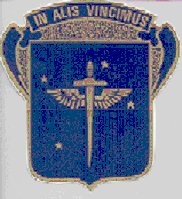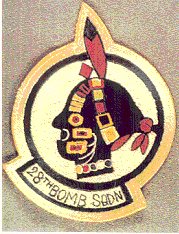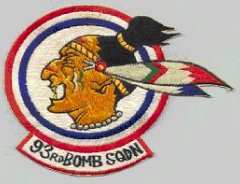The B-29 In Mig Alley
Bud Farrell
After the disastrous B-29 Vs. Mig-15 air battle of October 23rd 1951, which later became known as "Black Tuesday", with the loss of several 307th B-29's to Mig-15's over Namsi Airfield, North Korea, the 3 B-29 Groups (the 19 th Bomb Group, and 98th and 307th Bomb Wings) had to revert to night missions and rely on the cover and protection of darkness, with very few daylight raid exceptions for the balance of the war which ended on July 27th 1953. The Mig-15 had made the B-29 obsolete, and there was no immediate replacement aircraft yet available or appropriate for the type of missions required. B-29s had flown everything from frontline support, dropping on enemy troop concentrations, to bombing of rail lines, road supply truck routes, bridges, refineries, factories and last but NOT least ... North Korean AIRFIELDS!
The vulnerability of the B-29's, even under cover of darkness, was further proven in the night of June 10th 1952. Over the relatively innocuous railway bridge targets of Kwaksan, Mig -15s destroyed 3 and badly damaged several others of the 19th Bomb Group out of Kadena Air Force Base on Okinawa. All were caught in searchlights and then jumped by Migs!
Our crew arrived in the 19th Bomb Group on June 21st, 1952, just 10 days later. The apprehension from recent losses was very great, and very unsettling to us "rookies", with a great deal of gallows humor about "you won't need this or that very long"! Of course this is, was, and shall forevermore be commonly imposed on the new kids on the block! We had our turn six months later as WE were getting ready to go home! But for now it was "our turn in the barrel"!
After several orientation flights and related sessions with the Group Flight Surgeons Office on how to give in-flight blood transfusions etc, with the blood plasma kits we carried aboard the aircraft, we were ready for our first combat mission as a full crew. One of the first and most shocking briefing instructions to the Gunners, including the Bombardier/Nose Gunner, was that we were "absolutely NOT to fire unless we were clearly fired upon"! This went against the grain of everything we had been trained to do; a year and a half of intense Gung -Ho "slug -it -out" simulated attacks with gun camera passes by F-51 Mustangs and F-80 Shooting Star Jets over Colorado, Wyoming, Texas and Louisiana. What the hell is this "DON'T SHOOT?"
We were initiated on the night of July 3/4th. On our first mission, a Mig-15 appeared just off our left wing flying formation with us, very close in! The more senior Gunner on the crew we were replacing , "Brownie", said "watch this" ... and he took an Aldis lamp ( similar to the current Q-Beam Sport Type plug- in Spot Light)which was used for visual checks in the darkness for wing and control surface damage, engine checks, etc., and he held it in front of his face and under his chin , like we did as kids playing "flashlight', clicks it on, damn near blinding us in the Gunners compartment, and is making faces and giving the MIG the FINGER! "What the hell..."
With that, the cockpit light of the Mig comes on, the Mig drops its landing gear to slow down, is flying superb formation with us at our left wing tip and now he is giving US the finger! My heart is in my throat and these two are playing an early version of "road rage"! On the way back to Okinawa, about a 4-1/2 hour trip, I got a REAL briefing and the following was what was going on!
Earlier fighter aircraft, prop or jet propelled, had to fly what is called a "pursuit curve", the maneuver so frequently illustrated in pictures of a pilot's two hands making a pass at each other, with one having to make constant adjustment to the movement and changes in direction of the other. This "leading", or pointing of the nose of the attacking aircraft then required some distance from the target in order to make the adjustments while spotting, sighting, and making a firing pass. If the guy in close attempted to point his nose at you, he was past you before he could even bring the fighters gun platform to bear! Too CLOSE to the target and he was past the target before firing, too FAR out in the dark and he had NO target, due to loss of visual sighting, and there were then, in 1952, no radar Migs or air- to - air heat seeking or guided missiles, only ballistic missiles which went directly where they were pointed until they burned out and fell to the ground if missing their target, another aircraft.
Thus if the target, a bomber, had a fighter find it in the darkness by chance, following a slightly visible exhaust stack torch, spotted in a bright moonlight, or whatever, the fighter could stay with the bomber, fly close in and attempt to draw fire as another Bogey sat off a little ways getting vectored in with altitude, airspeed, heading, from the "Decoy". He could then make a pass - a pursuit curve -firing at the flashes from the multiple 50's of the bombers turrets, as the decoy dropped or dashed away to safety. No fire, no flashes, no damage, NO LOSSES! The value of a B-29, and its 11 or 12 man crew, with their repetitive offensive capability, was far greater than the possible reward of a single defensive Mig-15 with what we thought to be a relatively inexperienced North Korean or Chinese Pilot. We belatedly have learned that in 1952 some Russian, Czech, and Polish Pilots were flying Migs in combat over the Yalu. Nicknamed the "HONCHOS", they were experienced World War II pilots polishing new Jet skills and tactics, as were many of our Fighter Pilots, including many WW II Reservists recalled to active duty for Korea!
As a result of an earlier printing of this narrative, I received detailed correspondence from a crewmember who flew on the fateful January 30th 1953 mission for which Jim O'Meara volunteered to fly "just one more mission" - beyond his completed combat tour - and on which Jim was lost, as described in IN MEMORIUM late in this book. That mistakes are sometimes made resulting in such tragedy is difficult to relate at any time, but that the strict and extremely difficult to resist discipline of orders to "NOT FIRE UNLESS FIRED UPON", particularly during the fury and excitement of battle, may have proved disastrous in that one Gunner on that mission was reported to have previously frequently stated that he was "gonna get a Mig if it killed him" ... and sadly, it may very well have!
Tracking of bombers by fighters following up on vapor trails in cold weather, and in the brightness of moonlight, was another matter, and climatic conditions were well considered in the timing and altitude of bomb runs in order to preclude the creation of vapor trails whenever possible. But many aircraft were still lost or damaged under such unanticipated and changing conditions from briefing time to time over target, 4 or 5 hours later. We experienced many similar incidents of non- firing passes in the darkness on our next 24 missions, and of course we had some of our other 'friendlies" up there too, B-29s and Fighters, another good reason for very strict fire control.
The air battles included a great deal more, with radar directed AAA (anti Aircraft Artillery) fire of 85 MM, 88s, 90s, 105s, and supposedly up to 120 MM Heavy Guns putting up a box barrage in front of and at the altitude known for the bomber stream (through recon aircraft, radar etc.) flying in single trail, a SHORAN RADAR ( Short Range Radar Navigation) Arc, each plane flying the same arc, 30 to 60 seconds horizontal and 500 foot vertical separation, of up to as many as 66 B-29s on a max effort target up along the Yalu River. If flak, searchlights, enemy aircraft dropping illuminating parachute flares above us, and Migs, aren't a part of an air battle, then we weren't in many!
In WW II, great formations of hundreds of aircraft were fired at by hundreds of heavy guns, while the Korean War B-29 Crews, for at least a few minutes on some targets, had EVERY gun concentrating on ONE aircraft ... ... "Yours"! The searchlights from the I.P. (Initial Point) to the target were essentially to illuminate the B-29s for orbiting Migs, not particularly to light up B-29 targets for the ground gun crews since most AAA guns were radar controlled anyway. As radar controlled searchlights "locked on" B-29s, frequently "coning" one B-29 at the apex of the lights, Migs would pounce on the B-29 like Yellow Jackets out of their disturbed nest, the Antung Mig Base just across the Yalu/Border and within visual sight of most major Yalu River targets, and operating up to 525 Mig-15s that could not be taken out on their Chinese/Manchurian refuge bases because of the political vagaries of the Korean War.
In some "air battles", such as over the Suiho Hydroelectric Power Plant and Dam (then the 4th largest Hydroelectric Power Plant and Dam in the World) on September 12th, 1952, the searchlights were lined up like a boulevard on both sides of the Yalu River, tracking each aircraft that could not effectively jam (deflect) them with ECM (Electronic Counter Measures) . The Migs, in their intense pursuit of "coned targets", flew into and through some of their own flak. In spite of what was reported in official records and U.S.A.F. Korean Air War histories as a 307th Group ship shot down by fighters, that aircraft and crew were lost to a direct flak hit and resultant explosion with a full bomb load with burning wreckage falling on the Manchurian side of the River. That aircraft was directly in front of us and we reported at debriefing 5 hours later that there was "little or no possibility of survivors" ... and we were WRONG! The Right Gunner, 1 out of the 12 crewmembers aboard, had survived , evaded capture for 12 days, was a P.O.W. for 12 months, was repatriated in August of 1953 and I talked to him at Thanksgiving 1998. But that's another story, the most incredible that I could relate!
After Suiho, we started to get Marine Night Fighter cover by F3D-2 Sky- Nights, a side by side tandem seat radar jet fighter from Marine Squadron VMF(N)-513. On major Yalu targets, the F3Ds flew at higher altitudes orbiting between the I.P. and target, waiting for calls for assistance from the vulnerable B-29s flying their straight and level NO evasion bomb runs! The security of having this cover was a great morale boost, and we frequently had them fly and play almost in our prop wash in the dark, knowing that we, by agreement, were the "gang that couldn't shoot ... !!! It was great practice for their radar tracking skills but initially a little unnerving having an unidentified Bogey virtually on our tail ... ... one apparently doing barrel rolls back there!
On one mission our Radar Observer shouted on interphone "2 bandits (Migs) comin' in at 10 o'clock" ... my side! Heart in my throat I reacted "HIGH OR LOW?" "I can't tell you that, our radar only shows azimuth (horizontal plain), NOT vertical or altitude!" Peeled eyeballs never saw either of them but our Flight Engineer looking out his escape hatch window saw 2 rocket tail flames pass just above us on their way to our 4 o' clock level ... we NEVER fired! That same night at debriefing, reports of action and log position reports proved that one B-29 Crew had also impulsively fired at an unidentified aircraft - another B-29 in our Group, with a .50 caliber round stopping in the seat and underlying flak jacket of our Group Executive Officer, Capt. Eugene Smith! Needless to say, we were told again "DON'T SHOOT UNLESS FIRED UPON!"
In this strange war, with stranger limitations, political AND practical, B-29's dropped 167,000 tons of HE and Incendiary Bombs, more than the total dropped on Japan by B-29s in WW II, excluding the A-Bombs of course. We lost 34 B-29s in combat, several others (perhaps 48 more) to operational accidents related to equipment failure, severe weather, etc. And we lost several B-29's in the night raids of late December 1952 and through Spring of 1953, but the crews still saddled up knowing they couldn't shoot back ... unless clearly fired upon, letting the other guy throw the "first sucker punch"! What a marvelous gutsy gang, that gang that couldn't shoot ... !
As the 60th Anniversary of D-Day passed yesterday, June 6th, 2004, with all of the related images of sadness and individual courage, I reminisced, recalled, and dwelled for only a short while on my own combat crews moments of desperate effort and urgencies, paling in comparison yet overwhelming in emotion to our own set of "D-Days" ... those moments of extreme apprehension and anxiety that in themselves WERE our own "Longest Days" ... or "Longest Nights" ... just 25 times of "sweating it out" from takeoff 'til landing. While we did not see our fallen on a beach next to us, we had flashing explosive moments of friends disappearing into the night, never to be found, nor seen, nor ever heard from again ... each bomb run from the run-in at the I.P. through only a half hour over a target with apprehension beyond imagination, but to be repeated again and again for 24 more times ... not knowing what the next moment might bring ... extinction or exhilarating salvation ? And so our collective time in - or on our way to - combat of actually only 250 or so hours, or the cumulative equivalent of just 10 full days, has made its indelible mark just as surely as perhaps that first few moments off the ramp of a landing craft.
I cannot - and do not - by any means equate these experiences ... observing the loss of an aircraft and crew in front of or behind you in the dark will never intrude in your night as would the man next to you being lost ... but neither will either image fade in either beholders day ... or night ... nor ever! And my modest thoughts only amplified the magnitude of what that "Greatest Generation" did for us!
- Bud Farrell -
 19th Bomb Group "ON WINGS WE CONQUER!"
|  |
 |  |